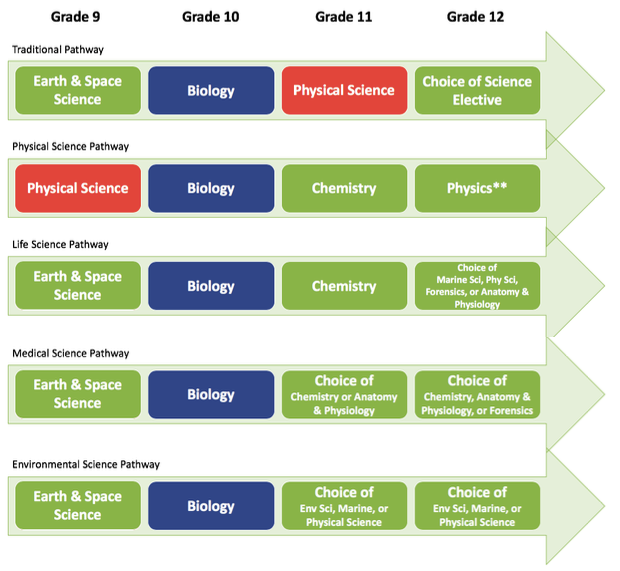Earth/Space Science (#2001310)
This course is an equally rigorous science course with a lab component that satisfies part of the science graduation requirement (see below)
3 Credits Science • One of which must be Biology 1, two of which must be equally rigorous science courses • Two of the three required course credits must have a laboratory component • Industry Certifications that lead to college credit may substitute for up to one science credit (except for Biology 1) • An identified computer science** course may substitute for up to one science credit (except for Biology 1)
Principal Approved District Final - Counts for 10% of Final Course Grade
For Placement in Grade 9:
Completion of Grade 8 M/J Comprehensive Science 3
For Placement Beyond Grade 10:
Students expressing a desire to follow an Environmental Pathway and have completed Biology.
For Placement in Grade 9:
Grade 8 M/J Comprehensive Science 3
For Placement Beyond Grade 10:
Biology 1
Gr 10 - Biology 1, Gr 11-12 - Any Equally Rigorous Science Course (See Pathways Below)
Academic Pathways for Science
Traditional Science Electives:
Anatomy & Physiology, Chemistry, Environmental Science, Forensic Science, Marine Science, Physics, Physical Science
Access the Instructional Materials page to see approved instructional resources for this course.
Study the earth and its location in space through experiments and observation to discover a wide range of principles in the earth sciences. The term earth science is a broad one, encompassing geology, paleontology, plate tectonics, astronomy, meteorology, and oceanography.
Laboratory investigations that include the use of scientific inquiry, research, measurement, problem solving, laboratory apparatus and technologies, experimental procedures, and safety procedures are an integral part of this course. The National Science Teachers Association (NSTA) recommends that at the high school level, all students should be in the science lab or field, collecting data every week. School laboratory investigations (labs) are defined by the National Research Council (NRC) as an experience in the laboratory, classroom, or the field that provides students with opportunities to interact directly with natural phenomena or with data collected by others using tools, materials, data collection techniques, and models (NRC, 2006, p. 3). Laboratory investigations in the high school classroom should help all students develop a growing understanding of the complexity and ambiguity of empirical work, as well as the skills to calibrate and troubleshoot equipment used to make observations. Learners should understand measurement error; and have the skills to aggregate, interpret, and present the resulting data (National Research Council, 2006, p.77; NSTA, 2007).




